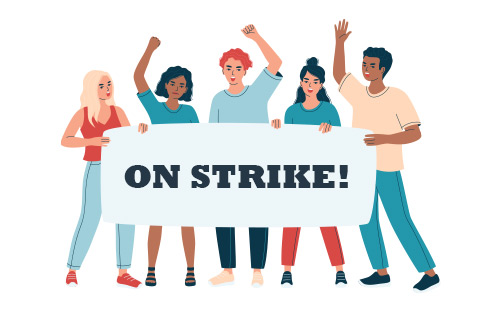[ad_1]

Hollywood studios, the Big Three automakers and Starbucks were just some of the employers impacted by a remarkable surge in labor strikes called by unions in 2023. Nearly 350 strikes took place in 2023 – the most in two decades.
According to data released by Bloomberg Law,[1] 345 strikes were called in 2023, along with two employer-initiated lockouts, for a total of 347 work stoppages impacting more than a half-million workers. The last time there were that many strikes in a year was 2003, though neither year topped strike activity between 1990 and 1994, when there were more than 500 strikes each year.
Some other interesting points from Bloomberg Law’s report.
- Although most strikes occurred during negotiations for a “successor” collective bargaining agreement – meaning a new contract to replace an expiring agreement – approximately 120 work stoppages in 2023 occurred in support of a union’s first labor contract, with another approximately 30 strikes taking place during the term of an existing labor contract. This represents a substantial shift from just a few years ago, when nearly all strikes occurred only in support of successor contract negotiations, suggesting that unions have become more impatient and are willing to strike in support of demands even during first-time contract negotiations.
- Two-thirds of all strikes called in 2023 ended within seven days, and fewer than 5% of strikes lasted more than 60 days, reflecting a trend over the past few years towards short duration strikes. In contrast, prior to 2020, approximately half of all strikes lasted longer than seven days.
- Strike activity traditionally has been directed at the manufacturing sector more than other industries. That was not the case in 2023. Last year, only 54 strikes were directed at manufacturer employers, continuing a trend over the past 20 years of a declining number of strikes against manufacturers. The majority of strikes in 2023 involved either service provider employers (126 strikes) or retail employers (105 strikes). But, like the majority of all strike activity, most of those service provider and retail strikes were short-lived.
- Strikes occurred in most parts of the country, but 12 states, mostly in the Rocky Mountain and Great Plains regions, had no strike activity at all. Unsurprisingly, those states with a heavy concentration of union-represented employees had the most strike activity. California experienced the greatest number of strikes (71), followed by New York (48) and Illinois (27). But again, even in those states, most strikes were very brief (47 of California’s 71 strikes ended in seven days or less; the same for 39 of New York’s 48 strikes).
- The Service Employees International Union (SEIU) called the most strikes in 2023 – 99 out of 345 strikes – followed by the Teamsters and two teachers’ unions. But, once again, more than 80% of these strikes resulted in work stoppages of a week or less.
So, can we expect this trend of more frequent but shorter duration strikes to continue in 2024? All indicators suggest it will: resurgence of union organizing activity, increased public support of unions and an uncertain economic and political climate. Employers with unionized workforces, and particularly those with collective bargaining agreements expiring in 2024, will need to plan accordingly.
[1] Union Strike Activity in 2023: Recent Development and Historical Perspectives, Bloomberg Law, 2024.
[ad_2]




